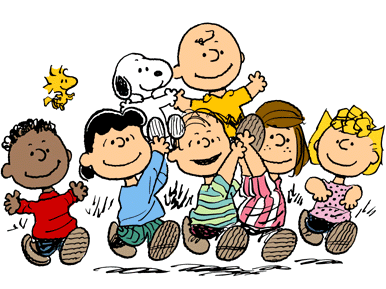 Peanuts and Gang.
Peanuts and Gang.I have produced the most widely circulated comic strips in Nigeria and the comics led me to my first big contract as a project artist for the Johns Hopkins University's Population Communication Services (JHU/PCS)in Nigeria. And I produced nine booklets of fully illustrated series on family planning methods in four local languages for use in all the family planning clinics in Nigeria. And growing up with "Peanuts" and other comics helped me to become a celebrated cartoonist in my teenage years in Nigeria. And at 20, my works were exhibited at the World Picture Book Fairs in far away Japan. I have to thank God for geniuses like Charles M. Schulz for the inspiration.
This book of the classic cartoons of the legendary Charles M. Schulz is one of the books you should give to your children. They will love it.
The Complete Peanuts: 1950-1952
by Charles M. Schulz
Good Ol' Charlie Brown
A Review by Chris Bolton
The Peanuts gang has literally been in my life forever. I've seen home movies of myself as a baby, playing with plastic toys of Charlie Brown, Snoopy, and Lucy long before I could have possibly understood who they were. I began ritually watching the holiday TV specials as a toddler, and I had a cherished Snoopy Sno-Cone Maker (and, briefly, a Snoopy electric toothbrush) in my early elementary school years. I spent entire weekend visits to my father's apartment reading his tattered mass market collections of vintage Peanuts comic strips, even as the newspapers carried current strips in which the art was sloppier and the punchlines notably sappier (that there was a three-decade gap between the strips in the books and the newspapers wasn't clear to me until I was a bit older).
Charles Schulz's creations were indelible. It wouldn't be overstating matters to say I grew up with them -- and, in time, grew out of them, as well. In my pre-teen years, Calvin and Hobbes caught my fancy, right around the same time I started to finally "get" Gary Larson's Far Side strips. As a teenager, I also became taken with Lynn Johnston's For Better or For Worse (the teenage son happened to be roughly the same age as me, which made his adolescent trials more compelling than Charlie Brown's forty-year-long unrequited crush on the little red-headed girl).
By that age, Charlie Brown felt like an anachronism. Schulz's deceptively simplistic drawing style and repetitive stories grew tiresome. Before long, Peanuts sat on a dusty shelf in the back of my mind, alongside other past-their-prime comic strips like Beetle Bailey, Mark Trail, Hagar the Horrible, and especially The Family Circus.
Thankfully, Fantagraphics Books has found a way to reinvigorate Peanuts -- by taking us back to the beginning. Their insanely ambitious Complete Peanuts series intends to bring out every single Peanuts strip Schulz ever drew, two books per year, for a projected total of twelve years. That's an incredible amount of work -- on Fantagraphics's end, yes, but it also highlights just how tireless Schulz was, especially considering he never used an assistant. Although I'll likely skip the later years (past 1980, let's say), the first four volumes do an excellent job of reminding those of us who forgot just how vital and hilarious Peanuts once was.
The first volume takes us from 1950, when Schulz sold his weekly strip "Li'l Folks" to United Feature Syndicate (which then retitled it "Peanuts," to Schulz's lifelong dismay), to 1952. If one can only afford a single volume in the series, this is the must-have. Here we see the very earliest renditions of good ol' Charlie Brown, as well as a supporting cast that will likely be alien to younger readers, including Violet, Patty (not Peppermint), and Shermy. Snoopy doesn't yet speak, or act like much more than an ordinary dog.
Charlie Brown himself, however, emerges almost fully formed. While he's a bit sharper-witted and more cynical than the perpetually defeated sad sack he would become, most of the unlucky boy's misfortune is in place, along with a few of his neuroses.
Devoted Peanuts fans may look upon the fourth volume (1955-1956) more fondly, as this is the point at which the strip begins to feel more like what it would eventually become -- albeit sharper, funnier, and still somewhat crueler. Snoopy utters his first words in this book (Schulz later turns his dialogue balloons into thought balloons, making Snoopy's voice a little more credible), which also introduces "Pig Pen" and gets the infant Linus on his feet and talking. And there's the added treat of another long-forgotten character Schulz ended up jettisoning: Charlotte Braun, whose name suggests a foil for Charlie Brown, although her only apparent personality trait is talking loudly (a quality that is ultimately folded, more fittingly, into Lucy's character).
The most astonishing aspect of these strips is the dark humor. While Schulz maintained a much-vaunted tone of sadness and longing throughout the strip's run, these books showcase the "causal cruelty and offhand humiliations" (to quote from Matt Groening) that kept the early years so sharp.
Take, for instance, the strip from Sunday, January 23, 1956, in which Charlie Brown futilely argues with the sun to stop melting his snowman. Standing over the slushy remnants of his creation, Charlie Brown laments, "There's nothing left! Only a memory and a carrot!" At which point Snoopy trots by, casually eats the carrot, and saunters off licking his lips, leading Charlie Brown to mutter, "Only a memory..."
Moments like these capture a poignancy that was missing from most of the day's other strips -- and isn't often found on modern comic pages, either. In addition, the earlier Peanuts had more of a playful, surreal streak, from Linus's square balloons to the September 27, 1956, strip in which a mortified Charlie Brown literally shrinks to half his size.
Four books into the series, The Complete Peanuts promises a dizzying array of delights for years to come; even if, like me, one chooses to eschew the post-'80s material, that still leaves eleven books to anticipate -- which means six more years of collecting. Compare Schulz's output to that of Bill Watterson's Calvin and Hobbes, which ran for ten years (minus two hiatuses) and fills three large, heavy hardcovers in the just-released The Complete Calvin and Hobbes. While Watterson's collection will possibly necessitate some reinforcing of one's bookshelf, the completed Peanuts project will likely require an entire bookcase of its own.
Given the choice, I prefer Watterson's tireless imagination and exquisite, intricate artwork. There's much less of it, true, but Watterson wisely quit before repeating himself, whereas Schulz continued tangling Charlie Brown in a kite-eating tree and having Lucy yank away footballs for arguably fifteen or twenty years longer than necessary.
And yet, there's no denying that Calvin and Hobbes could not have existed without Peanuts (Watterson himself freely acknowledges the debt). Schulz pioneered the transition of comic strip children from cuddly moppets to complex, multi-dimensional people. Furthermore, one can easily see the impact of Snoopy's animal impersonations (eventually including his play-acting as a "World War I flying ace" piloting his house/plane into dogfights with the Red Baron) on both Calvin's flights of fancy (i.e. Spaceman Spiff) and on the very character of Hobbes, a talking tiger.
Regardless of the quality of these strips, the Fantagraphics editions are simply beautiful to behold. Every volume is lovingly designed (by the artist Seth) with evocative covers and page spreads, and each includes a foreword by the likes of Matt Groening, Jonathan Franzen, and Walter Cronkite, along with a biography of Schulz. Best of all, the comic strips are arrayed in a manner befitting Schulz's simple but effective layouts. Those old paperbacks of my father's arranged the strips vertically like building blocks, one daily strip per page, with the first two panels on top of the last two, throwing off the precise rhythm of a horizontal strip. Sunday strips were often truncated and awkwardly divided over several pages. Fantagraphics restores the correct layout, remaining true to Schulz's original intentions, and even includes the expendable single-panel gags that opened most Sunday strips (newspaper and book editors often excised these for more space).
The Complete Peanuts is more than a necessary archive of a strip whose historical importance to the medium can't be overestimated. The word "essential" is bandied about a little too often with regard to collected editions, but there's no exaggeration in stating that The Complete Peanuts is essential to everyone who appreciates the perfect marriage of word and image that makes the comic form so unique and precious.
The adult in you will appreciate the artistry of Schulz's work. The kid in you will love the beagle pretending to be a rhino. Both will be delighted by The Complete Peanuts.
Copyright © 1994-2005 Powells.com · Terms of Use







2 comments:
Thanks for posting this interesting
story.
Marie
Maria,
thanks for reading it too.
God bless.
Post a Comment